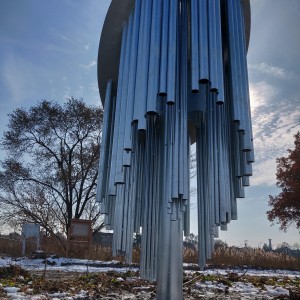Steel, patina, bluestone
8′-0″ x 12′-0″ diameter
Dunning Read Conservation Area, Chicago
Northwest Portage Walking Museum
Nesewin: How to Breathe Under Water is a steel sculpture that marks the trailhead at the Dunning Read Conservation Area in Chicago. It is part of the Northwest Portage Walking Museum, a project cosponsored by the Chicago Public Art Group, the American Indian Center, the Dunning Read Conservation Partners, and the Portage Park Neighborhood Association. It was designed by myself and Laura Miracle, with some fabrication by FLUX Studios.
Waters continue to rise in our region, physically and metaphorically, and nature and culture must adapt to survive. How do we breathe under water? Nesewin means ‘to breathe’ in the Anishinaabe language spoken by the 3 Fires Confederacy of indigenous people of the Chicago area.
Like so much of the Chicago watershed, the Dunning Reed Conservation Area is a wetland. Wetlands provide both abundance and scarcity– water-soaked soil creates a scarcity of oxygen for plant roots.
To develop the form for this sculpture we looked at native wetland plants, like willow and birch, to see how they have adapted to cycles of periodic flooding. We found the seed of our design in a morphological structure called aerenchyma. Aerenchyma are air spaces that wetland plants form in order to adapt to low oxygen environments. They allow for gas exchange between the submerged roots and the stems and leaves. Aerenchyma also provide buoyancy to help stabilize the plant in the water column.
Nesewin represents a cross-section of a willow stem revealing the openings of the aerenchyma. We saw the aerenchyma as a fitting conceptual metaphor for cultural resilience, and the continuing adaptation of indigenous populations to changing and often inhospitable environments.
This microscopic structure also mirrors a larger pattern of human history. The Chicago region has always been a place of intertribal exchange, of travel and trade, in and through the waterways. The carving of the Chicago and Des Plaines Rivers onto the face of the sculpture is meant to overlay the multiples scales of this concept.
Resilience, cultural survival, restoration, and the importance of water are all core concepts of the Northwest Portage Walking Museum and we hope this piece invites conversation and a deeper experience with the landscape and its layers of history.




